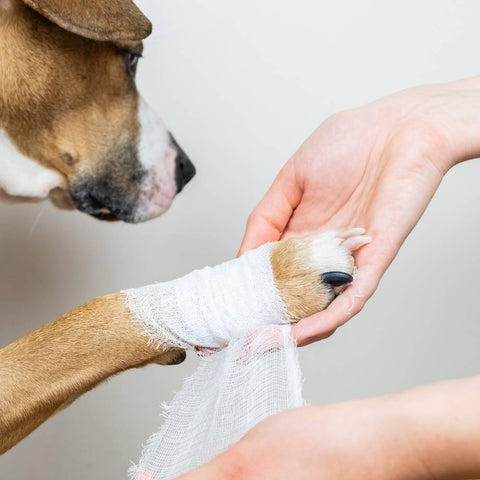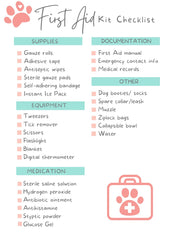
First Aid for Dogs: What You Need to Know
First Aid for Dogs: What You Need to Know
As a pet parent, you want to do everything you can to keep your furry friend healthy and happy. One important aspect of pet care is being prepared for any accidents or emergencies that may arise. This is where a dog first aid kit comes in.
A dog first aid kit is an essential item for all pet owners. It is a collection of supplies and tools that can help you provide immediate care to your dog in case of an emergency. Here are some additional tips to keep in mind when putting together a dog first aid kit:
- Keep it portable: Choose a small, waterproof container that is easy to carry with you when you are on the go with your dog.
- Customize it for your dog: Consider your dog's specific needs and the types of activities you participate in with your pet when selecting items for your kit. For example, if you walk your dog in areas where there are snakes, include a snake bite kit.
- Keep it well-stocked: Check your first aid kit regularly and replace any items that are missing or expired.
- Familiarize yourself with its contents: Take the time to learn how to use each item in your dog first aid kit so that you are prepared in case of an emergency.
- Know when to seek veterinary care: While a dog first aid kit can be a valuable resource, it is not a substitute for professional veterinary care. If your dog is injured or sick, seek veterinary attention as soon as possible.
By following these tips, you can ensure that your dog first aid kit is well-stocked and ready to use when you need it. With the right supplies and knowledge, you can provide quick and effective care to your fur baby in the event of an emergency.

What to Include in a Dog First Aid Kit
The contents of a dog first aid kit will vary depending on the needs of your individual dog, but here are some items that should be included in most kits:
- Gauze rolls and adhesive tape: These items can be used to wrap wounds and control bleeding.
- Antiseptic wipes or solution: Antiseptic wipes or solution can be used to clean wounds and prevent infection.
- Sterile non-stick gauze pads: These can be used to cover wounds and protect them from further damage.
- Tweezers: Tweezers can be used to remove splinters, ticks, or other foreign objects from your dog's skin.
- Scissors: Scissors can be used to cut gauze or clothing that may be impeding your dog's movement or causing discomfort.
- Muzzle: A muzzle can be used to prevent your dog from biting, even if they are friendly, if they are in pain or frightened.
- Flashlight: A flashlight can be used to check wounds or other areas of your dog's body in low light conditions.
- Instant cold pack: An instant cold pack can be used to reduce swelling caused by injuries or to help bring down a high body temperature in case of heatstroke.
- Pet first aid manual: A pet first aid manual can provide step-by-step instructions for treating common illnesses and injuries.
- Contact information for your vet: It is important to have your veterinarian's contact information on hand in case of an emergency.
- Blanket: A blanket can be used to keep your dog warm or as a makeshift stretcher to move them if necessary.
By including these items in your dog first aid kit, you can be prepared for a variety of emergencies and provide immediate care to your pet until you can get them to a veterinarian.
Prevention of Injuries
Preventing injuries is just as important as knowing how to treat them. Here are a few steps you can take to avoid common injuries in dogs:
- Keep your dog on a leash: This will prevent your dog from running into dangerous areas or into the path of a car.
- Keep your home and yard safe: Remove any potential hazards, such as sharp objects or toxic plants, from your dog's reach.
- Exercise caution during extreme weather: Do not leave your dog outside for extended periods of time during hot or cold weather.
- Watch for signs of exhaustion: Do not over-exercise your dog, especially during hot weather. Signs of exhaustion include heavy panting, lethargy, and loss of appetite.
- Train your dog: Basic obedience training can help prevent accidents and injuries.
- Watch your dog around other dogs: Some dogs may become aggressive or territorial, so it's important to supervise them around other dogs to prevent fights.
- Keep your dog's nails trimmed: Long nails can get caught on objects and cause injuries.
- Provide proper nutrition: A balanced diet and proper weight can help prevent joint problems and other health issues that can lead to injuries.
By following these simple steps, you can help reduce the risk of injuries to your dog and ensure they stay healthy and happy. However, knowing how to treat common illnesses and injuries could help save your dog’s life in an emergency.

Treatment of Common Illnesses and Injuries
- Bleeding: If your dog is bleeding, apply direct pressure to the wound with a sterile gauze pad or clean cloth. If the bleeding does not stop, seek veterinary attention immediately.
- Burns: For minor burns, run cool water over the affected area for several minutes. Apply a sterile gauze pad to the burn and seek veterinary attention if necessary.
- Heatstroke: Symptoms of heatstroke in dogs include heavy panting, rapid breathing, and a high body temperature. To treat heatstroke, move your dog to a cool place, offer water, and place a cool, damp cloth on their neck, chest, and back. Seek veterinary attention immediately.
- Poisoning: If you suspect your dog has ingested poison, call your veterinarian or an animal poison control center immediately. Have all the information available about the cause of the poisoning with you when you call.
- Strains or Sprains: For strains or sprains, immobilize the affected limb and keep your dog as quiet as possible. Apply a cold pack to reduce swelling and seek veterinary attention if necessary.
Conclusion
In conclusion, having a dog first aid kit and knowing how to treat common illnesses and injuries can be the difference between life and death for your furry friend. Always seek veterinary attention if you are unsure of how to treat an injury or illness, or if your dog's condition worsens.

